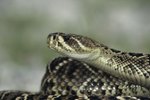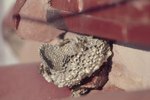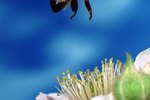
Because yellow jackets are unable to survive the cold temperatures of winter, every year a colony undergoes a predictable cycle of seasonal growth and decline. While the population grows throughout the spring and peaks in late summer, dwindling resources and dropping temperatures soon kill off the colony, leaving virtually no survivors by the end of the year; the remaining few go into hibernation.
End of Summer Mating
Several months of consistent mating and feeding can make a yellow jacket colony grow to hundreds or even thousands of members by the end of summer each year. Around the time that the population peaks -- typically around August -- the colony produces queens. These are yellow jackets that will mature and leave the colony as resources begin dwindling, and they are the only members of the colony that will survive the winter. Their final act before going into hibernation at the end of summer is mating, ensuring that the colony's legacy continues even as its living members perish in the impending cooler weather.
Hibernating Hiding Places
Yellow jacket queens are not able to withstand the cold temperatures of winter any better than other members of the colony, so they do not spend those months out in the open. To hibernate, they must seek out a safe and secluded hiding place. Typical spaces include underground holes, brush and compost piles, hollow logs, tree cavities and firewood piles. Queens may also take shelter in human enclosures, like inside attics and crawl spaces. Once they find their hiding places, they enter a state of hibernation for several months.
Emerging from Hibernation
After hibernating, which typically lasts from about November until mid- to late April, a yellow jacket queen awakens and emerges from her hibernation spot. Completely alone, she preys on insects and whatever nectar sources she can find to regain her strength and find the energy to start looking for a new nesting site. Yellow jackets build paper nests, so using nothing but scavenged materials like tree back and her own saliva, the queen is able to begin construction of a new home for herself and her future colony -- old nests frequently don't survive the winter, and are never reused.
A New Colony Begins
Once the queen builds approximately 40 or 50 cells, she lays an egg in each one. The eggs hatch in about one week, and the queen begins feeding the larvae prey that she brings back to the nest. Within about one month, the larvae go through the pupal stage and mature into adult workers. These yellow jackets begin working to expand the nest, breed and grow the colony for the next several months, repeating the life cycle of growth, death and hibernation all over again. The queen that survived the winter and started the new colony will be among those that do not survive the subsequent autumn.
References
- Clemson Cooperative Extension: Yellow Jackets
- North Carolina State University Department of Entomology: Non-Honey Bee Stinging Insects In North Carolina
- University of Illinois Extension: Yellowjacket Control—Now is the Best Time to Do It
- University of Nebraska-Lincoln Extension: Acreage Insights: Life Outside the City Limits: August Animal - Yellow-jacket Wasp
- Mass Audobon: Bees and Wasps
- Newfoundland and Labrador Department of Environment and Conservation: Wasps (Yellow Jackets)
Photo Credits
-
David De Lossy/Photodisc/Getty Images
Writer Bio
Tom Ryan is a freelance writer, editor and English tutor. He graduated from the University of Pittsburgh with a degree in English writing, and has also worked as an arts and entertainment reporter with "The Pitt News" and a public relations and advertising copywriter with the Carnegie Library of Pittsburgh.




